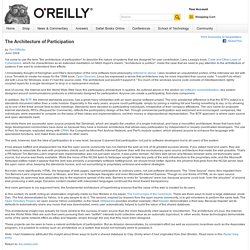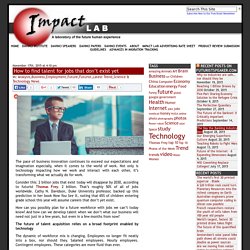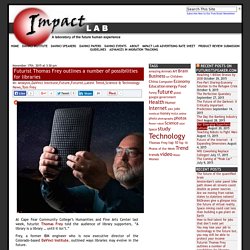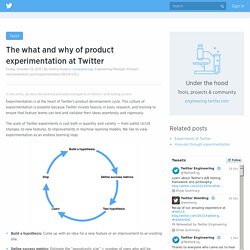

Financieel-management. “Ik eet mijn Nike’s op als Finance de architect of choreograaf zou zijn van het verdienmodel van de toekomst!”

, zei een jonge bevlogen startup founder onlangs tijdens de opening van het Jaarcongres Finance Transformation. De toon is gezet en het mag voor iedereen geen verrassing zijn dat de wereld exponentieel snel verandert. Veel organisaties lijken ‘verdraaid’ en ‘vast’ te zitten in hun eigen systeem. Uit onderzoek blijkt dat 50% tot 70% van de medewerkers min of meer ‘afgehaakt’ is. Het gevolg is een chronische onderbezetting van kennis, talent, passie en plezier.
Veel succesvolle en nieuwe startups zien in dat de huidige manier van (samen)werken en systemen aan een grens gekomen is. Om de status quo te doorbreken gaan de startups niet het (concurrentie)gevecht met de bestaande businessmodellen aan. The Architecture of Participation. By Tim O'Reilly June 2004 I've come to use the term "the architecture of participation" to describe the nature of systems that are designed for user contribution.

Larry Lessig's book, Code and Other Laws of Cyberspace, which he characterizes as an extended meditation on Mitch Kapor's maxim, "architecture is politics", made the case that we need to pay attention to the architecture of systems if we want to understand their effects. I immediately thought of Kernighan and Pike's description of the Unix software tools philosophy referred to above. I also recalled an unpublished portion of the interview we did with Linus Torvalds to create his essay for the 1998 book, Open Sources. Linus too expressed a sense that architecture may be more important than source code. And of course, the Internet and the World Wide Web have this participatory architecture in spades. In addition, the IETF, the Internet standards process, has a great many similarities with an open source software project.
Grille de caracterisation des organisations. How to find talent for jobs that don’t exist yet. The pace of business innovation continues to exceed our expectations and imagination especially, when it comes to the world of work.

Not only is technology impacting how we work and interact with each other, it’s transforming what we actually do for work. Consider this: 2 billion jobs that exist today will disappear by 2030, according to futurist Thomas Frey. 2 billion. That’s roughly 50% of all of jobs worldwide. Cathy N. Davidson, Duke University professor, backed up this prediction in her book Now You See It, noting that 65% of children entering grade school this year will assume careers that don’t yet exist.
Futurist Thomas Frey outlines a number of possibilities for libraries. Frey, a former IBM engineer who is now executive director of the Colorado-based DaVinci Institute, outlined ways libraries may evolve in the future.

Some 2 billion jobs will disappear by 2030, Frey predicted, as software and apps disrupt traditional businesses. The emerging “sharing economy” will create more enterprises like Uber and Airbnb, with independent operatives linked by apps. More workers, he suggested, will be freelancers, temps, independent contractors and self-employed entrepreneurs “co-working” in collaborative spaces very different from the traditional office. Bedrijven als speeltuin voor de duistere drie. Business process reengineering. Business Process Reengineering Cycle Business process re-engineering is a business management strategy, originally pioneered in the early 1990s, focusing on the analysis and design of workflows and business processes within an organization. BPR aimed to help organizations fundamentally rethink how they do their work in order to dramatically improve customer service, cut operational costs, and become world-class competitors.[1] In the mid-1990s, as many as 60% of the Fortune 500 companies claimed to either have initiated reengineering efforts, or to have plans to do so.[2]
Startpagina Deeleconomie. Growth Hacking. Free Vehicle Mileage Expense Log. The Free Printable Vehicle Mileage Log can be used to track mileage of your business vehicles for tax or other business tracking purposes.

The printable vehicle mileage log in Adobe Acrobat PDF format is designed for you to print out and keep in the vehicle so you can enter your starting and ending mileage by hand. The additional link below to our Premium Vehicle Auto Expense Form is a Microsoft Excel spreadsheet that includes columns for date, odometer start/end, trip miles, purpose/description and total. The spreadsheet version will auto calculate the total mileage at the bottom. Download Vehicle Mileage Expense Log Premium Vehicle Mileage Expense Log – Excel for $3.97 Vehicle Mileage Expense Log.
The what and why of product experimentation at Twitter. Experimentation is at the heart of Twitter’s product development cycle.

This culture of experimentation is possible because Twitter invests heavily in tools, research, and training to ensure that feature teams can test and validate their ideas seamlessly and rigorously. The scale of Twitter experiments is vast both in quantity and variety — from subtle UI/UX changes, to new features, to improvements in machine learning models. We like to view experimentation as an endless learning loop: Build a hypothesis: Come up with an idea for a new feature or an improvement to an existing one.Define success metrics: Estimate the “opportunity size” — number of users who will be affected by the change. A/B Testing, decision-making, and innovation. Negenvlaksmodel (Maes) Business Model Canvas.